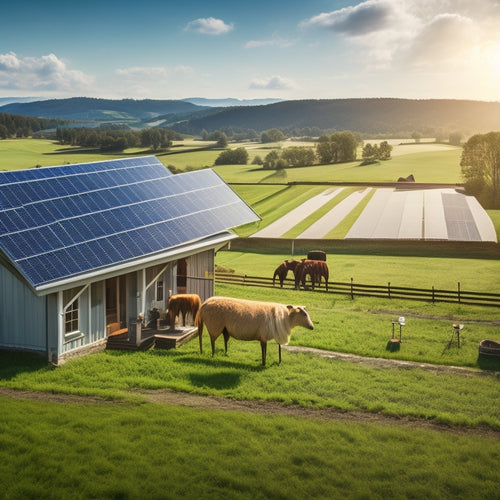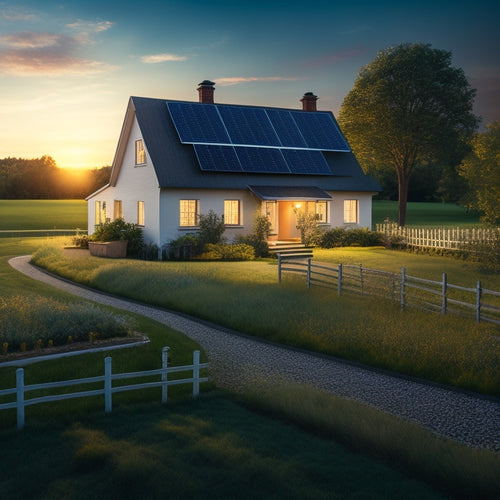Closet Organization With a Spark: Eco-Friendly Storage Solutions
Share
You're ready to spark a change in your closet with eco-friendly storage solutions. Start by repurposing old containers, swapping traditional hangers for hooks, and incorporating natural fiber baskets. Add a touch of rustic charm with reclaimed wood shelves and energy-efficient lighting. Sustainable fabrics, eco-labels, and recycled materials will elevate your closet's style while promoting a healthier planet. As you embark on the world of eco-friendly closet organization, you'll discover innovative solutions to maximize space, reduce waste, and support a good cause, leading you to a more conscious and stylish you, one step at a time.
Key Takeaways
• Repurposed storage bins and energy-efficient lighting reduce waste and energy consumption in the closet.
• Sustainable fabrics, eco-labels, and reclaimed wood shelves promote a healthier planet and add rustic charm.
• Hanging organizers made from recycled materials and eco-friendly shelving units elevate closet style and support environmentally responsible practices.
• Upcycling old containers and repurposing old items reduce waste, add a personal touch, and promote a circular economy.
• Adopting small, sustainable habits, such as using reusable cloth bags and sustainable hangers, can make a significant difference in the closet's environmental impact.
Eco-Friendly Closet Essentials
To create a sustainable and environmentally conscious closet space, incorporate eco-friendly essentials like repurposed storage bins, energy-efficient lighting, and sustainable fabrics that reduce your carbon footprint.
As you set out on this journey, develop a closet manifesto that outlines your commitment to sustainable style. Look for eco labels that guarantee the products you choose meet rigorous environmental standards. By adopting green habits, you'll be reducing waste and promoting a healthier planet.
Start by selecting repurposed storage bins made from recycled materials or sustainable sources. These bins won't only reduce waste but also add a touch of eco-chic to your closet.
Next, consider energy-efficient lighting options like LED bulbs or solar-powered lights. These alternatives will notably reduce your energy consumption and lower your carbon footprint.
Sustainable Shelving Options
As you outfit your closet with eco-friendly essentials, swap out traditional shelving for sustainable options that not only reduce waste but also add a touch of modern sophistication to your space.
You'll be delighted to discover that sustainable shelving options aren't only eco-friendly but also aesthetically pleasing.
One fantastic option is reclaimed wood shelving, which breathes new life into discarded wood, reducing waste and preserving history.
For a more modern take, consider bamboo alternatives, which are highly renewable and require minimal resources to cultivate.
These eco-friendly shelving options won't only elevate your closet's style but also clear your conscience.
Plus, they're incredibly durable, ensuring your shelving unit will stand the test of time.
By choosing sustainable shelving, you'll be supporting environmentally responsible practices while creating a peaceful, organized oasis that sparks joy.
Repurposed Storage Containers
When it comes to repurposing storage containers, you'll find that everyday items can be transformed into clever closet organizers.
For instance, you can reuse glass jars to store small items like buttons or safety pins, or upcycle old fabric to create stylish and functional bins for storing clothing or accessories.
Reused Glass Jars
You can transform empty glass jars into versatile storage containers for your closet by simply cleaning and decorating them. This eco-friendly solution is perfect for storing small items like buttons, safety pins, or beads.
To get started, collect various-sized glass jars and thoroughly clean them with soap and water. Remove any residue or labels, and let them dry completely.
Next, decorate your jars using paint, stickers, or decoupage to give them a personalized touch. Add a label to each jar using a permanent marker or create custom jar labels to identify the contents.
You can also add a decorative ribbon or twine around the lid for a rustic touch.
Use your reused glass jars to store items like jewelry, makeup, or accessories. You can place them on a shelf or in a corner of your closet, keeping your belongings organized and within reach.
This creative glass storage solution isn't only eco-friendly but also adds a touch of rustic charm to your closet. By repurposing glass jars, you'll reduce waste and create a unique storage system that sparks joy and inspires creativity.
Upcycled Fabric Bins
Transform old fabric scraps, t-shirts, or tote bags into functional storage bins that add a touch of personality to your closet by upcycling them into unique fabric bins. This eco-friendly approach not only reduces waste but also gives new life to vintage textiles and fabric remnants.
You'll love the rustic charm and character that upcycled fabric bins bring to your closet.
Benefits of using upcycled fabric bins:
1. Personalized style: Each bin is one-of-a-kind, reflecting your personal taste and flair.
2. Soft and gentle: Fabric bins are perfect for storing delicate items, such as lingerie or accessories.
3. Easy to clean: Simply spot clean or machine wash and dry your fabric bins to keep them looking fresh and clean.
Natural Fiber Baskets
Natural fiber baskets, woven from materials like rattan, wicker, or seagrass, add a touch of organic elegance to your closet's storage solutions.
As you incorporate these baskets into your closet organization, you'll appreciate the unique woven textures and earthy accents they bring.
The art of basket weaving is a time-honored craft that requires great skill and attention to detail.
When sourcing natural fibers, look for suppliers that prioritize sustainable harvesting practices to promote the long-term health of the environment.
Handcrafted designs and artisanal touches make each basket a one-of-a-kind piece that adds character to your closet.
By choosing natural fiber baskets, you're not only reducing your environmental footprint but also supporting artisans and small-scale farmers.
When selecting baskets, consider the specific needs of your closet.
For example, a woven rattan basket might be perfect for storing bulky items like blankets, while a smaller wicker basket could be ideal for organizing accessories.
With natural fiber baskets, you can create a beautifully organized and eco-friendly closet that sparks joy and serenity.
Zero-Waste Closet Hacks
As you aim to minimize waste in your closet, consider swapping traditional hangers for hooks to maximize space and reduce clutter.
You'll also want to think creatively about repurposing old containers to store small items, giving new life to items that might otherwise end up in the landfill.
Swap Hangers for Hooks
How many hangers are currently cluttering your closet, taking up valuable space and making it difficult to find what you need?
It's time to swap out those hangers for a more eco-friendly and efficient solution: hooks! By making the switch, you'll not only free up space but also reduce waste and create a more organized closet.
Maximize vertical space: Hooks make the most of your closet's vertical space, allowing you to store more items in a smaller area.
Reduce clutter: With hooks, you can hang items like bags, accessories, and outerwear, keeping them off the floor and out of the way.
Easy to use: Hooks are simple to install and easy to use, making it a breeze to hang and retrieve your belongings.
Repurpose Old Containers
You can transform old containers into clever storage solutions, giving new life to items you might otherwise discard while keeping your closet organized and waste-free.
Think beyond the original purpose of old jars, baskets, or boxes, and envision them as unique storage vessels. For instance, a vintage mason jar can become a quaint holder for small accessories like buttons, safety pins, or beads. A worn-out shoe box can be revamped into a storage container for socks, hats, or scarves.
Get creative with your vintage makeovers by adding a fresh coat of paint, decorative stickers, or a sprinkle of glitter. You can also upcycle old cardboard boxes into dividers for your shelves or drawers.
With a little imagination, you can turn trash into treasure, reducing waste and adding a personal touch to your closet. By repurposing old containers, you're not only reducing waste but also injecting a touch of personality into your closet.
Donate Unused Items
By passing on gently used or never-used items to those who need them, you're not only freeing up valuable closet space but also giving someone the opportunity to breathe new life into something that would have otherwise collected dust.
Donating your gently used items can have a profound impact on your community.
Support local charities: Partner with local charities, thrift stores, and shelters to donate items that can be resold or repurposed to support their cause.
Utilize donation apps: Take advantage of donation apps that connect you with local organizations and individuals in need, making it easy to give back.
Organize community drives: Rally your community to collect gently used items and donate them to local shelters, thrift stores, or online marketplaces that support a good cause.
DIY Closet Organizer Ideas
With a little creativity and some basic materials, transforming your closet into a stylish and functional space can be a fun and rewarding DIY project.
By incorporating custom shelves, you can maximize your closet's vertical space and create a sense of openness. Use space planners to visualize your closet layout and identify areas for improvement.
Consider a double-hang rod system to double your hanging space, and add shelf dividers to keep folded items organized. If you have a large closet, consider adding a folding table or a hidden compartment for additional storage and functionality.
When designing your closet layout, think about the items you use most frequently and place them in easy-to-reach locations.
Use storage systems, such as baskets or bins, to store items like socks and accessories.
By incorporating these DIY elements, you'll be able to create a functional and stylish closet that reflects your personal style.
With a little creativity and some elbow grease, you can turn your closet into a peaceful oasis that sparks joy and inspires creativity.
Green Closet Design Tips
As you design your dream closet, you're likely thinking about more than just aesthetics - you're considering the environmental impact too.
When it comes to creating a green closet, you'll want to focus on eco-friendly materials, sustainable shelving options, and nature-inspired color schemes that bring the outdoors in.
Eco-Friendly Materials Matter
You'll substantially reduce your carbon footprint by choosing eco-friendly materials for your closet design, from sustainable wood to low-VOC paints. By making conscious choices, you'll not only create a beautiful and functional closet, but also contribute to a healthier planet.
-
Biodegradable textiles: Opt for biodegradable textiles, such as hemp or bamboo, for your closet's upholstery and accessories. These sustainable materials reduce waste and support environmentally responsible manufacturing practices.
-
Recycled papers: Use recycled papers for your closet's decorative accents, such as wallpaper or drawer liners. This creative approach reduces paper waste and adds a touch of personality to your space.
-
Reclaimed wood: Incorporate reclaimed wood into your closet design for a unique, eco-friendly touch. This sustainable material reduces waste, conserves natural resources, and adds a touch of sophistication to your space.
Sustainable Shelving Options
Designing your closet's shelving with sustainability in mind can greatly reduce waste and minimize environmental impact, and opting for eco-friendly shelving materials is a crucial step in creating a truly green closet space.
You'll want to choose materials that not only reduce waste but also promote a healthier environment.
Consider using reclaimed wood for your shelving units. This eco-friendly option reduces the demand for newly harvested wood and gives old, discarded wood a new life.
Another sustainable option is bamboo frames, which are highly durable and require minimal maintenance. Bamboo is also a highly renewable resource, making it an excellent choice for environmentally conscious individuals.
When selecting shelving materials, look for certifications like FSC (Forest Stewardship Council) or Oeko-Tex, which guarantee the materials meet rigorous environmental and social standards.
Nature-Inspired Color Schemes
Two of nature's most calming hues, sage green and sandy beige, can bring a sense of serenity to your closet space when incorporated into a nature-inspired color scheme. These Earthy tones will create a peaceful ambiance, making it easier to start your day feeling refreshed and focused.
To take your closet's color scheme to the next level, consider the following nature-inspired options:
-
Forest hues: Incorporate rich shades of brown and green to evoke the feeling of a forest glade.
-
Botanical shades: Soft pink, lavender, and powder blue can bring a touch of whimsy and playfulness to your closet.
-
Meadow palette: Soothing shades of yellow, orange, and pink can create a bright and cheerful atmosphere.
You can also draw inspiration from the Sky inspirations with soft blues and whites, or Oceanic colors like turquoise and aqua.
Conscious Closet Maintenance
By adopting a conscious approach to closet maintenance, you can prevent clutter from building up and keep your space organized, functional, and stress-free.
You must recognize that clutter isn't just a physical issue, but also a mental one. You may have a clutter mindset, where you hold onto items 'just in case' or because of emotional attachment.
To overcome this, establish closet rituals that work for you. Set aside time each week to maintain your space, whether it's 10 minutes a day or an hour on the weekend.
Start by putting away items that are out of place, and then move on to more significant tasks like sorting and donating.
Eco-Chic Closet Accessories
As you maintain your closet's organization, you'll want to complement your space with eco-chic accessories that not only elevate its style but also promote sustainability.
These fashionable fixtures won't only make your closet look stunning but also contribute to a greener planet.
Three must-have eco-chic closet accessories for your space include:
Reclaimed wood shelves: Add a touch of rustic charm to your closet with shelves made from reclaimed wood.
Not only do they look stunning, but they also reduce waste and preserve natural resources.
Hanging organizers made from recycled materials: Keep your clothes organized and make a statement with hanging organizers crafted from recycled materials.
These innovative accessories reduce waste and promote a more circular economy.
Energy-efficient lighting: Illuminate your closet with energy-efficient lighting solutions that not only save energy but also reduce your carbon footprint.
Sparkling shelves and a well-lit closet have never looked so good!
Small Steps to Big Impact
You can make a significant difference in your closet's environmental impact by incorporating small, sustainable habits into your daily routine.
It's not about making drastic changes, but rather adopting mindful consumption practices that add up over time.
Start by taking stock of your closet's contents and identifying areas where you can make Simple Swaps. For instance, replace single-use garment bags with reusable cloth bags or swap out plastic hangers for sustainable alternatives.
Implementing these small changes can have a significant impact when combined with a commitment to reducing waste.
Consider adopting a 'one in, one out' policy to maintain a balanced wardrobe and reduce the likelihood of unnecessary purchases.
By being more intentional with your shopping habits, you'll reduce your carbon footprint and create a more sustainable closet environment.
Frequently Asked Questions
Can I Use Eco-Friendly Closet Organizers in Small or Irregularly Shaped Closets?
You can definitely use eco-friendly closet organizers in small or irregularly shaped closets by maximizing corner utilization and being space savvy, incorporating custom-fit shelves and multi-functional storage units to optimize every inch.
How Do I Properly Clean and Maintain Natural Fiber Baskets?
You gently dust natural fiber baskets with a soft-bristled brush, then spot clean stains with a damp cloth; for tougher messes, mix 1 tablespoon of mild soap with 1 cup of warm water, ensuring fiber durability.
Are Repurposed Storage Containers as Durable as Traditional Storage Options?
When evaluating repurposed storage containers, you'll want to assess their durability through material testing, ensuring they meet your needs for container longevity, as they can be just as durable as traditional options with proper care.
Can I Incorporate Eco-Friendly Closet Organization Into a Rented Space?
You face the renter's dilemma, but can still incorporate sustainable decor into your closet organization; opt for removable, eco-friendly storage solutions that won't damage the space, ensuring a harmonious blend of style and responsibility.
Are Eco-Friendly Closet Organizers More Expensive Than Traditional Options?
You'll find that eco-friendly closet organizers can be pricier, but bear in mind material costs and make price comparisons. While sustainable materials might be more expensive upfront, they'll save you money in the long run.
Related Posts
-

Solar Power Systems for Cost-Effective Sustainability
Investing in solar power systems is a smart move for cost-effective sustainability. You can save about $1,500 annuall...
-

Solar Power Systems for Rural Properties
Solar power systems offer a reliable and efficient energy solution for rural properties, allowing you to gain energy ...
-

Cost-Effective Solar Solutions for Rural Homes
Cost-effective solar solutions can alter your rural home by enhancing energy independence and slashing utility bills....


